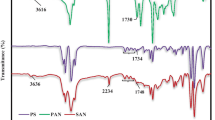Abstract
The first example of organostibine mediated controlled/living random copolymerization of styrene (St) and methyl methacrylate (MMA) was achieved by heating a solution of St/MMA/organostibine mediator at 100 °C or St/MMA/organostibine mediator/AIBN with various monomer feed ratios at 60 °C. The addition of AIBN significantly decreased the reaction temperature and enhanced the rate of copolymerization. The structure of poly(St-co-MMA) was verified by 1H NMR. The reactivity ratios at 60 °C were determined by the extended Kelen-Tüdős method to be γSt = 0.40 and γMMA = 0.44. The ln([M]0/[M]) increased linearly with increasing reaction time. The number-average molecular weights of poly(St-co-MMA) increased linearly with conversion. Poly(St-co-MMA) with expected number-average molecular weight and low polydispersity index was formed. The living characteristic was further confirmed by chain-extension of poly(St-co-MMA) to form poly(St-co-MMA)-b-PMMA.
Similar content being viewed by others
References
Moad G, Rizzardo E, Thang SH. Toward living radical polymerization. Acc Chem Res, 2008, 41: 1133–1142
Braunecker WA, Matyjaszewski K. Controlled/living radical polymerization: Features, developments, and perspectives. Prog Polym Sci, 2007, 32: 93–146
Sciannamea V, Jerome R, Detrembleur C. In situ nitroxide-mediated radical polymerization (NMP) processes: Their understanding and optimization. Chem Rev, 2008, 108: 1104–1126
Matyjaszewski K, Xia JH. Atom transfer radical polymerization. Chem Rev, 2001, 101: 2921–2990
Mayadunne RTA, Rizzardo E, Chiefari J, Chong YK, Moad G, Thang SH. Living radical polymerization with reversible addition-fragmentation chain transfer (RAFT polymerization) using dithiocarbamates as chain transfer agents. Macromolecules, 1999, 32: 6977–6980
David G, Boyer C, Tonnar J, Ameduri B, Lacroix-Desmazes P, Boutevin B. Use of iodocompounds in radical polymerization. Chem Rev, 2006, 106: 3936–3962
Yamago S, Iida K, Yoshida J. Organotellurium compounds as novel initiators for controlled/living radical polymerizations. Synthesis of functionalized polystyrenes and end-group modifications. J Am Chem Soc, 2002, 124: 2874–2875
Yamago S, Ray B, Iida K, Yoshida J, Tada T, Yoshizawa K, Kwak Y, Goto A, Fukuda T. Highly versatile organostibine mediators for living radical polymerization. J Am Chem Soc, 2004, 126: 13908–13909
Yamago S, Kayahara E, Kotani M, Ray B, Kwak Y, Goto A, Fukuda T. Highly controlled living radical polymerization through dual activation of organobismuthines. Angew Chem Int Edit, 2007, 46: 1304–1306
Ray B, Kotani M, Yamago S. Highly controlled synthesis of poly (N-vinylpyrrolidone) and its block copolymers by organostibine-mediated living radical polymerization. Macromolecules, 2006, 39: 5259–5265
Yamago S. Precision polymer synthesis by degenerative transfer controlled/living radical polymerization using organotellurium, organostibine, and organobismuthine chain-transfer agents. Chem Rev, 2009, 109: 5051–5068
Gu B, Liu SS, Leber JD, Sen A. Nitroxide-mediated copolymerization of methyl acrylate with 1-alkenes and norbornenes. Macromolecules, 2004, 37: 5142–5144
De la Fuente JL, Fernandez-Garcia M, Fernandez-Sanz M, Madruga EL. A comparative study of methyl methacrylate/butyl acrylate copolymerization kinetics by atom-transfer and conventional radical polymerization. Macromol Rapid Commun, 2001, 22: 1415–1421
Kubo K, Goto A, Sato K, Kwak Y, Fukuda T. Kinetic study on reversible addition-fragmentation chain transfer (RAFT) process for block and random copolymerizations of styrene and methyl methacrylate. Polymer, 2005, 46: 9762–9768
Koumura K, Satoh K, Kamigaito M. Mn-2(CO)(10)-induced controlled/living radical copolymerization of methyl acrylate and 1-hexene in fluoroalcohol: High alpha-olefin content copolymers with controlled molecular weights. Macromolecules, 2009, 42: 2497–2504
Gan LM, Lee KC, Chew CH, Ng SC, Gan LH. Copolymerization of styrene and methyl methacrylate in ternary oil-in-water microemulsions: monomer reactivity ratios and microstructures by 1H NMR and 13C NMR. Macromolecules, 1994, 27: 6335–6340
Maxwell IA, Aerdts AM, German AL. Free radical copolymerization: An NMR investigation of current kinetic models. Macromolecules, 1993, 26: 1956–1964
Kotani Y, Kamigaito M, Sawamoto M. Living random copolymerization of styrene and methyl methacrylate with a Ru(II) complex and synthesis of ABC-type “block-random” copolymers. Macromolecules, 1998, 31: 5582–5587
Ziegler MJ, Matyjaszewski K. Atom transfer radical copolymerization of methyl methacrylate and n-butyl acrylate. Macromolecules, 2001, 34: 415–424
Matyjaszewski K, Ziegler MJ, Arehart SV, Greszta D, Pakula T. Gradient copolymers by atom transfer radical copolymerization. J Phys Org Chem, 2000, 13: 775–786
Kelen T, Tüdős F. Analysis of the linear methods for determining copolymerization reactivity ratios. I. New improved linear graphic method. J Macromol Sci Chem, 1975, A9(1): 1–27
Tüdős F, Kelen T, Földes-berezsnich T, Turcsányi B. Analysis of linear methods for determining copolymerization reactivity ratios. III. Linear graphic method for evaluating data obtained at high conversion levels. J Macromol Sci Chem, 1976, A10(8):1513–1540
Tüdős F, Kelen T. Analysis of the linear methods for determining copolymerization reactivity ratios. V. Planning of experiments. J Macromol Sci Chem, 1981, A16(7): 1283–1297
Uebel JJ, Dinan FJ. A reassessment of the 1H-NMR spectra of styrene/methyl methacrylate copolymers. J Polym Sci Polym Chem Ed, 1983, 21: 2427–2438
Kale LT, O’Driscoll KF, Dinan FJ, Uebel, JJ. A reinvestigation of the reported 1H-NMR spectra of poly(styrene-co-methyl methacrylate). J Polym Sci Part A: Polym Chem, 1986, 24: 3145–3149
Fukuda T, Ma YD, Inagaki H. Free-radical copolymerization. 3. Determination of rate constants of propagation and termination for styrene/methyl methacrylate system. A critical test of terminal-model kinetics. Macromolecules, 1985, 18: 17–26
ASBrar P. Synthesis of styrene/methyl methacrylate copolymers by atom transfer radical polymerization: 2D NMR investigations. J Polym Sci Part A: Polym Chem, 2006, 44: 2076–2085
Author information
Authors and Affiliations
Corresponding author
Rights and permissions
About this article
Cite this article
Zhang, Q., Li, J., Liu, Z. et al. Organostibine mediated controlled/living random copolymerization of styrene and methyl methacrylate. Sci. China Chem. 53, 2318–2323 (2010). https://doi.org/10.1007/s11426-010-4138-1
Received:
Accepted:
Published:
Issue Date:
DOI: https://doi.org/10.1007/s11426-010-4138-1




